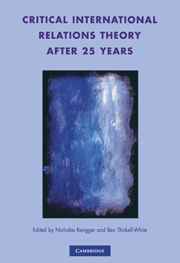Book contents
- Frontmatter
- Contents
- Preface
- Notes on contributors
- Editors' Introduction
- Looking back from somewhere: reflections on what remains ‘critical’ in critical theory
- Transnational theories of order and change: heterodoxy in International Relations scholarship
- Happy Anniversary! Time and critique in International Relations theory
- Is critical theory always for the White West and for Western imperialism? Beyond Westphilian towards a post-racist critical IR
- The promise of critical IR, partially kept
- Towards a sociology of global morals with an ‘emancipatory intent’
- Between Kant and Pufendorf: humanitarian intervention, statist anti-cosmopolitanism and critical international theory
- Index
The promise of critical IR, partially kept
Published online by Cambridge University Press: 06 July 2010
- Frontmatter
- Contents
- Preface
- Notes on contributors
- Editors' Introduction
- Looking back from somewhere: reflections on what remains ‘critical’ in critical theory
- Transnational theories of order and change: heterodoxy in International Relations scholarship
- Happy Anniversary! Time and critique in International Relations theory
- Is critical theory always for the White West and for Western imperialism? Beyond Westphilian towards a post-racist critical IR
- The promise of critical IR, partially kept
- Towards a sociology of global morals with an ‘emancipatory intent’
- Between Kant and Pufendorf: humanitarian intervention, statist anti-cosmopolitanism and critical international theory
- Index
Summary
Abstract. The critical turn in IR promised a continuous archeology of the field, an empathetic understanding of those we study, and a social science unwedded to the pursuit of universally valid laws. In the United States, this movement was rooted more in a critique of peace research, than in a critique of the ‘NeoNeo’ mainstream, to which it became sort of official opposition’. The promise has not been fulfilled because the research strategies of critical theorists have rarely given them direct access to the understandings of those outside the privileged core of world society. Other research programmes, including that of the Human Development Reports and of some feminists and ethnographic scholars in IR, have been more successful.
The light through a high stained glass window in Helsinki's National Museum (a masterpiece of the early twentieth-century National Romantic Style) draws eyes upward to three allegorical figures: ‘Arkeologi’, ‘Ethnografi’, ‘Historia’. They could be images of what the twenty-five year old critical turn in International Relations (IR) promised, and of what has only partially been fulfilled: a continuous archeology of the field of IR (a constant critical reflection on how we have built our knowledge, aimed at offering reasonable hypotheses about the interests that we have served), a commitment to a detailed, empathetic understanding of those we study (a methodological commitment that was going out of fashion in the early 1980s), and the willing embrace of a ‘social science [that] does not envisage any general or universally valid laws which can be explained by the development of appropriate generally applicable theories’, for, as Robert W. Cox reminded us, ‘both human nature and the structures of human interaction change, if only very slowly. History is the process of their changing.’
- Type
- Chapter
- Information
- Critical International Relations Theory after 25 Years , pp. 117 - 134Publisher: Cambridge University PressPrint publication year: 2007

